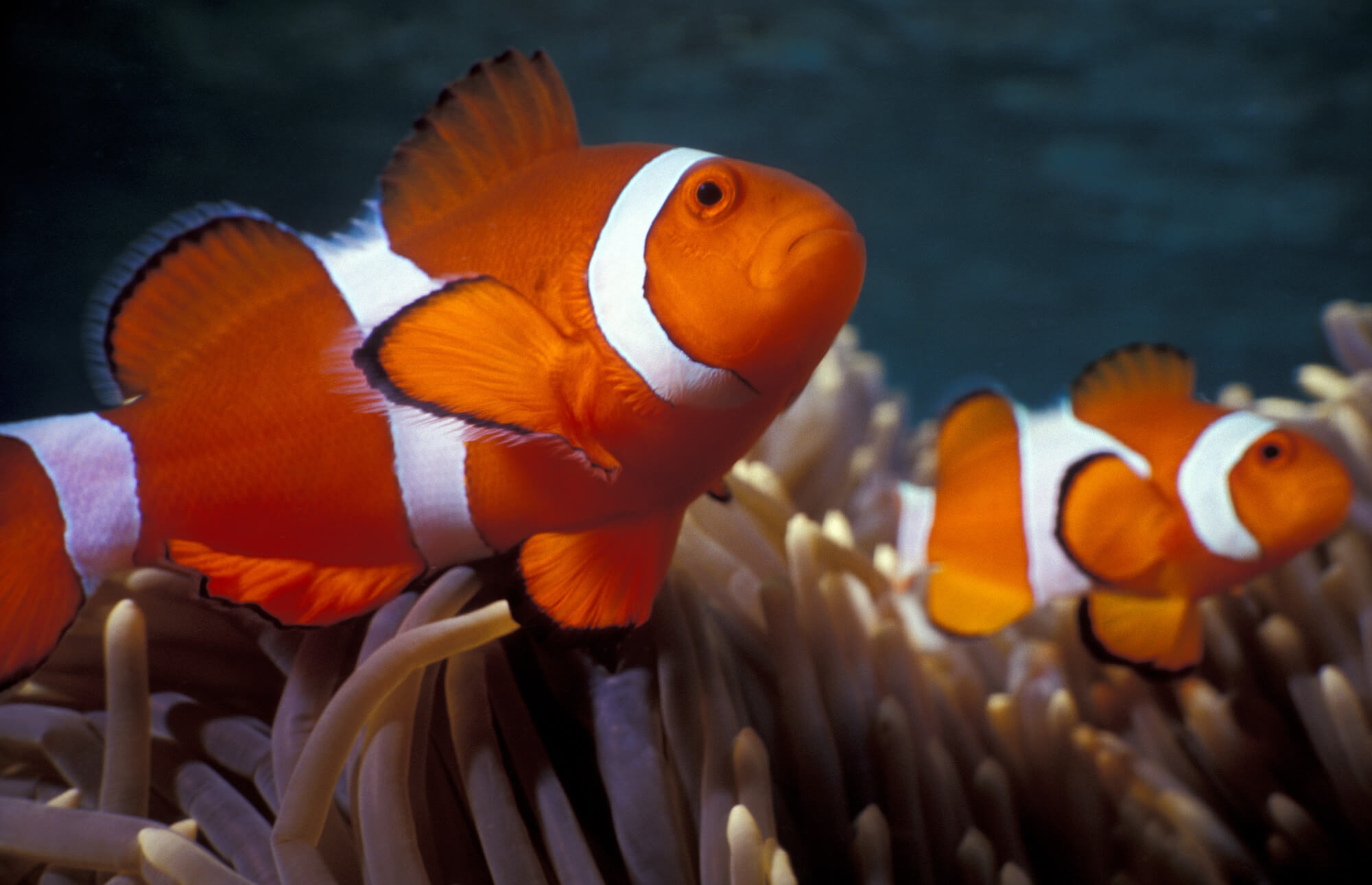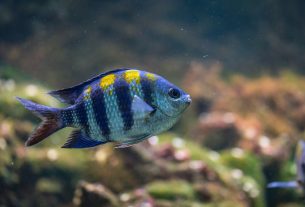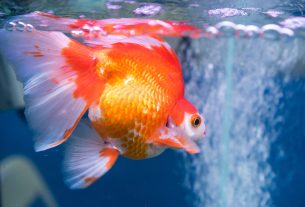Natural from warm, shallow waters, the clownfish is one of the best-known marine creatures in the world, largely due to the film Looking for Nemo, from Disney. These little fish have a very complex, but very interesting and functional way of life.
Their relationship with their offspring, the power hierarchy between females and males and their connection and dependence on anemones are just some of the factors that make clownfish one of the great wonders of marine life.
We have prepared this content to answer all your questions about these sea clowns. Shall we go to the text? Good reading! 🐠
Types of Clownfish
Clownfish are part of the group of Amphiprion, whose family is that of Pomacentridaewhich has 29 subdivisions of species and 5 subgenera:
- Amphiprion ephippium
- Flared
- Paramphiprion
- Actinicola
- Amphiprion clarkii
The famous Nemo belongs to the species Amphiprion Percula e Amphiprion Ocellaris. Despite being recognized as part of the group, the animals of the two species present some differences, although their characteristics and way of life are practically the same..
Clownfish Characteristics
The best-known fish of this species have an orange hue and three horizontal white stripes towards the front, with some thin stripes between the larger white ones.
However, other fish of the species may have a different appearance, with bluish, black, yellowish color and stripes in different sizes, shapes and places.

It is an animal that it can reach 11 centimeters, and females are larger than males. These fish are found in calm, warm and shallow waters, generally in the Pacific and Indian Oceans, around the regions of Australia, Philippines, China, Japan, Thailand and Malaysia.
Lifestyle
Clownfish have a very curious way of life. They are beings that do the symbiosis process (relationship between different species) with anemones, invertebrate animals that live in corals and release substances that are highly toxic to crustaceans and fish, or better yet: to almost all fish.
Due to the mucous membrane they have on their scales, clownfish are immune to this poison, which allows them to live in these beings, in a symbiotic relationship with anemones.
This partnership can be called a protocooperation, that is, in which both win: the fish gains a hiding place from predators and a place to live and lay eggs; the anemone guarantees its food, as the clownfish attracts other fish close by and leaves food scraps, and the cleaning of its tentacles.
It is a bond that works for both sides and guarantees longevity for both species.
reproduction
There is another curious fact about this species: there is no copulation between the male and the female. What happens is the male approaches to enchant the female. If you manage to conquer her, she is responsible for depositing the eggs in the anemone.
From that moment on, the male is responsible for fertilizing and caring for these eggs and cleaning the anemone. The female, dominant of the species, is responsible for laying eggs and scaring off predators.
After fertilization, All offspring of the species are born males. That’s right! As they are hermaphrodite animals, they can transform into females when the school needs them, generally in adulthood.

When this happens, it is because the female died or abandoned the anemone. Then, the oldest male in the hierarchy turns into a femalethus continuing the natural reproduction cycle of the species.
It is important to say that they are monogamous beings and usually live for many years with one partner.
Food
The clownfish is an omnivorous being, with a very varied diet that can involve different food classes. In this symbiotic relationship with anemones, their diet also ends up being related to the diet of these invertebrates, with leftovers from dead animals.
In general, these fish can feed on:
- Dead tentacles of anemones
- Cameroon
- Small crustaceans
- Plankton
- Copepods
- Zooplankton
- Began
Communication
They are extremely communicative beings and use this language to protect themselves from predators on the reef, organize social life inside the anemone and also to give warnings of possible prey and dead animals that are close to the corals.
Contrary to what was imagined a few centuries ago, these little fish are very “talkative”. They do this through pops, grunts, gurgles and clicks. Furthermore, they can also use their small teeth to create communication with the anemone itself.
This is part of an entire underwater language that is only being discovered now, with the application of new technological equipment capable of capturing the sounds and communication of beings that live in the sea.
The Discovery Brasil channel released an excerpt from a documentary about the sounds produced by clownfish. See how useful and complex this communication can be:
Habits
Its habits are very well established, and the female is in charge of the anemone’s entire social life. In this habitat, there is a limit to how many fish can live there. In general, the number of “tenants” does not exceed 6, but only 2 of them can mate.
During the day, they all go hunting for their own food and also for the anemone. They are highly hygienic animals, which live by cleaning the place where they live and the tentacles of anemones.
They will hardly move away from the anemone, as it offers almost complete protection against other species. By moving too far away from this location, they run a serious risk of being killed by larger predators, in addition to leaving their eggs vulnerable to hunting by damselfish, wrasses and sea stars.
Lifetime
In the wild, can live up to 10 years. In aquariums, between 4 and 6 years. However, there is another factor that can shorten the lifespan of clownfish: the bleaching of corals.
This is due to the devastating effects of climate change in recent decades, which affect the lives of all living beings on Earth, including these beautiful fish.
Even though it is not on the list of endangered species, the animal, which is completely dependent on the anemone, may no longer find a home in the seas. As ocean temperatures rise, many corals end up dying, creating a cycle of devastation for all beings that depend on this symbiotic process.
How to have a clownfish at home?
The dream of almost every aquarist is to be able to breed and maintain saltwater fish, and the clown species are the most chosen by those just starting out in the practice.
Clownfish aquarium
Initially, the aquarium must have a capacity of at least 150 liters of water, so that the anemones can also be housed. Coral sand is highly recommended as a substrate for the aquarium, while real corals should never be installed.
As they are saltwater fish, care must be taken with the water, as the animals need a clean environment and in accordance with the needs of each of the residents who will be part of the aquarium.
The water must be low in nitrate and phosphorus and rich in oxygen. Other recommendations that must be followed:
- Water temperature: from 24º to 28º
- Water pH: from 8.0 to 9.0
- Density: 1.023 a 1.025
- Salinity: around 29 and 35 ppt
To keep everything safe and without risk to the fish and corals inside, invest in a filtration, lighting and water pumping system, helping to ensure good oxygenation in the aquarium.
Don’t forget to carry out periodic maintenance and change a quarter of the water every two weeks.
Anemones
This is something you should take seriously: remember when we said that clownfish can’t survive without it? When these little fish are in aquariums, most can only tolerate a single species of anemone. Otherwise, they may feel stressed and not be able to maintain a useful life in that space.

Remember that anemones are sensitive to the water conditions in the aquarium, especially the temperature of the light, which needs to be intense, while the current must be indirect and gentle.
For your aquarium to be able to keep all its members in full health, you can choose between three species of anemones: Mertens anemone, Stichodactyla gigantea e Heteracts are magnificent.
How much does a clownfish cost?
The price of a clownfish varies according to the species, the stage of the animal’s life and region of the country. On average, the cost to purchase this fish for your aquarium is between R$35 e R$80.
Can I breed clownfish with other fish?
Yes, after all, every Nemo needs his Dory! Jokes aside, clownfish in the aquarium can live peacefully with other species of Amphiprion, as long as there is no overcrowding. If you want to keep several fish, invest in a larger tank, depending on your needs.
Pay attention to whether the fish’s white stripes are changing color. If this happens, the ideal is to seek a specialized veterinarian, as this could be a sign that the animal is becoming ill.
Did you see how interesting and charming the lives of these little fish are? Whether at sea or in the aquarium, they are the true representation of marine beauty. To provide even more quality of life for him, invest in products that can improve his health and well-being. Just click on the banner below!
Advertising professional, pedagogue, passionate about life and extremely curious.
Voracious reader of various subjects, passionate about technology and explorer of the pet world.

Sign up for our newsletter and stay up to date with exclusive news
that can transform your routine!
Warning: Undefined array key "title" in /home/storelat/public_html/wp-content/plugins/link-whisper-premium/templates/frontend/related-posts.php on line 12
Warning: Undefined array key "title_tag" in /home/storelat/public_html/wp-content/plugins/link-whisper-premium/templates/frontend/related-posts.php on line 13




